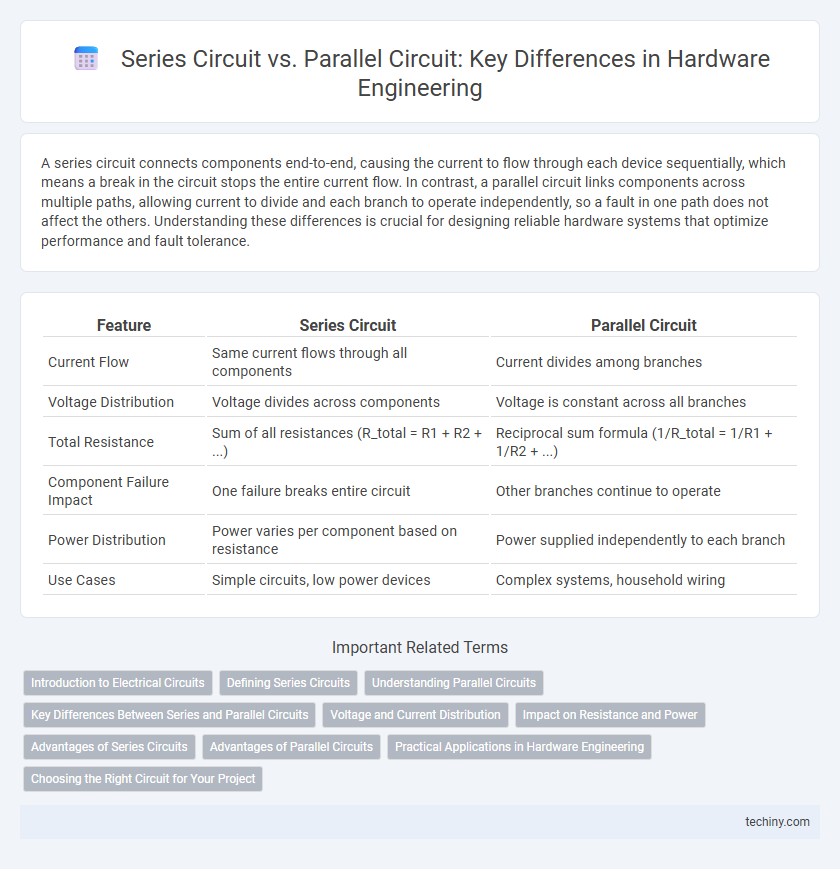A series circuit connects components end-to-end, causing the current to flow through each device sequentially, which means a break in the circuit stops the entire current flow. In contrast, a parallel circuit links components across multiple paths, allowing current to divide and each branch to operate independently, so a fault in one path does not affect the others. Understanding these differences is crucial for designing reliable hardware systems that optimize performance and fault tolerance.
Table of Comparison
| Feature | Series Circuit | Parallel Circuit |
|---|---|---|
| Current Flow | Same current flows through all components | Current divides among branches |
| Voltage Distribution | Voltage divides across components | Voltage is constant across all branches |
| Total Resistance | Sum of all resistances (R_total = R1 + R2 + ...) | Reciprocal sum formula (1/R_total = 1/R1 + 1/R2 + ...) |
| Component Failure Impact | One failure breaks entire circuit | Other branches continue to operate |
| Power Distribution | Power varies per component based on resistance | Power supplied independently to each branch |
| Use Cases | Simple circuits, low power devices | Complex systems, household wiring |
Introduction to Electrical Circuits
A series circuit connects components end-to-end, allowing current to flow through a single path, making voltage drop add up across each element. A parallel circuit links components across common points, creating multiple paths for current and maintaining the same voltage across all branches. Understanding the differences between series and parallel circuits is fundamental for designing and analyzing electrical systems in hardware engineering.
Defining Series Circuits
A series circuit is an electrical circuit where components are connected end-to-end in a single path for current flow. The current remains constant throughout all components, but the total voltage is the sum of individual voltage drops across each element. This configuration causes the overall resistance to increase as more components are added, affecting the circuit's performance and behavior.
Understanding Parallel Circuits
Parallel circuits distribute electrical current evenly across multiple branches, ensuring that each component operates independently with the same voltage. This configuration enhances circuit reliability because a failure in one branch does not interrupt the entire system, unlike series circuits where current travels through a single path. Understanding parallel circuits is essential for designing efficient hardware systems that maintain consistent performance and minimize downtime.
Key Differences Between Series and Parallel Circuits
Series circuits feature components connected end-to-end, creating a single path for current flow, resulting in voltage drops shared across all components. Parallel circuits connect components across the same two points, allowing multiple paths for current, which keeps voltage constant across each branch. The key difference lies in fault tolerance: a break in a series circuit stops all current flow, whereas a parallel circuit maintains operation in unaffected branches.
Voltage and Current Distribution
In a series circuit, the voltage is divided across each component while the current remains constant throughout all elements, making the current uniform but voltage drop variable. Conversely, in a parallel circuit, voltage across each branch remains equal while the total current is distributed among the branches according to their resistance, ensuring voltage uniformity but current division. Understanding these distinctions in voltage and current distribution is critical for designing efficient hardware systems with predictable electrical behavior.
Impact on Resistance and Power
In hardware engineering, series circuits increase total resistance by summing individual resistances, reducing power flow through each component. Parallel circuits decrease overall resistance, as total resistance is inversely proportional to the sum of the reciprocals of each resistor, enabling higher power distribution across components. This fundamental difference impacts the efficiency and performance of electronic devices, influencing design decisions based on desired voltage and current characteristics.
Advantages of Series Circuits
Series circuits offer a simple design with a single path for current flow, making them easy to analyze and troubleshoot in hardware engineering. They provide consistent current throughout all components, which is advantageous for applications requiring uniform current levels. The lower complexity reduces manufacturing costs and increases reliability in devices where failure detection is critical.
Advantages of Parallel Circuits
Parallel circuits provide consistent voltage across all components, ensuring each device operates at optimal performance levels. They allow for independent control of each branch, so the failure of one component does not disrupt the entire circuit. This configuration enhances system reliability and simplifies troubleshooting in complex hardware engineering applications.
Practical Applications in Hardware Engineering
Series circuits are commonly used in hardware engineering for applications requiring a single path for current flow, such as in sensor chains where sequential activation is critical. Parallel circuits dominate in power distribution systems within devices, ensuring consistent voltage across components like LEDs or resistors and allowing independent operation. Practical hardware designs often combine series and parallel configurations to optimize performance, reliability, and power efficiency.
Choosing the Right Circuit for Your Project
Selecting the right circuit configuration depends on the specific requirements of your hardware project, such as voltage, current, and reliability needs. Series circuits are ideal for applications requiring uniform current flow and simple design, while parallel circuits offer consistent voltage and better fault tolerance by allowing individual components to operate independently. Evaluating factors like power consumption, component sensitivity, and circuit complexity ensures optimal performance in hardware engineering designs.
Series Circuit vs Parallel Circuit Infographic

 techiny.com
techiny.com